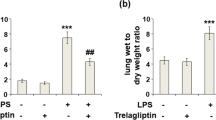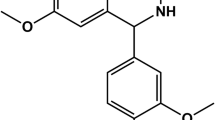Abstract
Objective and design
An animal experiment was performed to demonstrate the anti-inflammatory effects of an alpha-lipoic acid (ALA) derivative, dihydrolipoyl histidinate zinc complex (DHLHZn) for acute lung injury (ALI) and to investigate the mechanism of action.
Material
Rats were randomly divided into three experimental groups: control group (n = 17), DHLHZn(−) group (n = 11, ALI model rats), and DHLHZn(+) group (n = 12, ALI model rats treated by DHLHZn).
Treatment
Lipopolysaccharides (LPS, 10 mg/kg) were administered intratracheally in the DHLHZn(−) group and the DHLHZn(+) group. For the DHLHZn(+) group, DHLHZn (100 mg/kg) was administered intraperitoneally 2 h prior to LPS administration.
Methods
Four hours after LPS administration, bronchoalveolar lavage fluid (BALF) and lung tissue were collected. The findings were analyzed using the Mann–Whitney U test.
Results
Total number of cells, number of neutrophils and lymphocytes, levels of various inflammatory cytokines, and NF-kB p65 concentration of BALF were significantly lower in the DHLHZn(+) group than in the DHLHZn(−) group (p < 0.05). ALI pathology scores were significantly lower in the DHLHZn(+) group than in the DHLHZn(−) group (p < 0.001).
Conclusions
Anti-inflammatory effects of DHLHZn for ALI were demonstrated by BALF and histopathological findings. The mechanism of action of DHLHZn was considered to be via inhibition of the NF-kB signaling pathway. DHLHZn is thus suggested to be a new prophylactic agent for ALI.







Similar content being viewed by others
References
Wheeler AP. Acute lung injury and the acute respiratory distress syndrome: a clinical review. Lancet. 2007;369:1553–64.
Wyncoll DL. Acute respiratory distress syndrome. Lancet. 1999;354:497–501.
Lehr HA. Microcirculatory dysfunction in sepsis: a pathogenetic basis for therapy? J Pathol. 2000;190:373–86.
Riedemann NC. The enigma of sepsis. J Clin Invest. 2003;112:460–7.
Munford RS. Sensing gram-negative bacterial lipopolysaccharides: a human disease determinant? Infect Immun. 2008;76:454–65.
Davis MR. Purification and visualization of lipopolysaccharide from Gram-negative bacteria by hot aqueous-phenol extraction. J Vis Exp. 2012;63:e3916.
Liu F. Lipopolysaccharide-induced acute lung injury in rats: comparative assessment of intratracheal instillation and aerosol inhalation. Toxicology. 2013;304:158–66.
Ishii K. Attenuation of lipopolysaccharide-induced acute lung injury after (pro)renin receptor blockade. Exp Lung Res. 2015;41:199–207.
Reed LJ. Crystalline alpha-lipoic acid; a catalytic agent associated with pyruvate dehydrogenase. Science. 1951;114:93–4.
Jordan SW. A new metabolic link. The acyl carrier protein of lipid synthesis donates lipoic acid to the pyruvate dehydrogenase complex in Escherichia coli and mitochondria. J Biol Chem. 1997;272:17903–6.
Machado RS. Construction and properties of pyruvate dehydrogenase complexes with up to nine lipoyl domains per lipoate acetyltransferase chain. FEMS Microbiol Lett. 1992;79:243–8.
Masuda T. Dihydrolipoyl histidinate zinc complex, a new antioxidant, attenuates hepatic ischemia-reperfusion injury in rats. J Gastroenterol Hepatol. 2011;26:1652–8.
Hagiwara S. New lipoic acid derivative drug sodium zinc dihydrolipoylhistidinate prevents cardiac dysfunction in an isolated perfused rat heart model. Crit Care Med. 2011;39:506–11.
Kono Y. Antiproliferative effects of a new α-lipoic acid derivative, DHL-HisZnNa, in HT29 human colon cancer cells in vitro. Expert Opin Ther Targets. 2012;16(Suppl 1):S103–9.
Morakinyo AO. Effects of alpha lipoic acid on blood lipids, renal indices, antioxidant enzymes, insulin and glucose level in streptozotocin-diabetic rats. Biology and Medicine. 2013;5:26–33.
Carrier B. Anti-obesity and lipid-lowering properties of alpha-lipoic acid. J Hum Nutr Food Sci. 2013;1:1002.
Han T. A systematic review and meta-analysis of α-lipoic acid in the treatment of diabetic peripheral neuropathy. Eur J Endocrinol. 2012;167:465–71.
Xu Q. Meta-analysis of methylcobalamin alone and in combination with lipoic acid in patients with diabetic peripheral neuropathy. Diabetes Res Clin Pract. 2013;101:99–105.
Suh SH. Alpha-lipoic acid attenuates lipopolysaccharide-induced kidney injury. Clin Exp Nephrol. 2014;19:82–91.
Li G. Alpha-lipoic acid exerts anti-inflammatory effects on lipopolysaccharide-stimulated rat mesangial cells via inhibition of nuclear factor kappa B (NF-κB) signaling pathway. Inflammation. 2014;38:510–19.
Ogata, K. WO World Intellectual Property Organisation Patent, WO 2004/024139 A1, 2004.
Chen J. Docosahexaenoic acid (DHA) attenuated paraquat induced lung damage in mice. Inhal Toxicol. 2013;25:9–16.
Liu MW. Protective effect of Xuebijing injection on paraquat-induced pulmonary injury via down-regulating the expression of p38 MAPK in rats. BMC Complement Altern Med. 2014;14:498.
Sato N. Randomized study of the benefits of preoperative corticosteroid administration on the postoperative morbidity and cytokine response in patients undergoing surgery for esophageal cancer. Ann Surg. 2002;236:184–90.
Ono S. Effects of neutrophil elastase inhibitor on progression of acute lung injury following esophagectomy. World J Surg. 2007;31:1996–2001.
Suda K. Neutrophil elastase inhibitor improves postoperative clinical courses after thoracic esophagectomy. Dis Esophagus. 2007;20:478–86.
Zhang WJ. Alpha-lipoic acid inhibits TNF-alpha-induced NF-kappaB activation and adhesion molecule expression in human aortic endothelial cells. FASEB J. 2001;15:2423–32.
Watanabe K. Rat CINC, a member of the interleukin-8 family, is a neutrophil-specific chemoattractant in vivo. Exp Mol Pathol. 1991;55:30–7.
Himi T. Production and gene expression of IL-8-like cytokine GRO/CINC-1 in rat nasal mucosa. Acta Otolaryngol. 1997;117:123–7.
Moine P. NF-kappaB regulatory mechanisms in alveolar macrophages from patients with acute respiratory distress syndrome. Shock. 2000;13:85–91.
Bachofen M. Alterations of the gas exchange apparatus in adult respiratory insufficiency associated with septicemia. Am Rev Respir Dis. 1977;116:589–615.
Matthay MA. The acute respiratory distress syndrome: pathogenesis and treatment. Annu Rev Pathol. 2011;6:147–63.
Rittirsch D. Acute lung injury induced by lipopolysaccharide is independent of complement activation. J Immunol. 2008;180:7664–72.
Hilary C. The role of MAPK in drug-induced kidney injury. J Signal Transduct. 2012;2012:463617.
Acknowledgements
The authors are grateful to Seigo Kitano, MD, PhD, FACS, the president of Oita University, for assisting in the study and its publication.
Author information
Authors and Affiliations
Corresponding author
Ethics declarations
Conflict of interest
The authors declare that they have no conflict of interest.
Ethical approval
All procedures performed in studies involving animals were in accordance with The Keio University Institutional Animal Care and Use Committee (Approval Number: 08073).
Additional information
Responsible Editor: Yoshiya Tanaka.
Rights and permissions
About this article
Cite this article
Shoji, Y., Takeuchi, H., Fukuda, K. et al. The alpha-lipoic acid derivative DHLHZn: a new therapeutic agent for acute lung injury in vivo. Inflamm. Res. 66, 803–811 (2017). https://doi.org/10.1007/s00011-017-1059-x
Received:
Revised:
Accepted:
Published:
Issue Date:
DOI: https://doi.org/10.1007/s00011-017-1059-x




